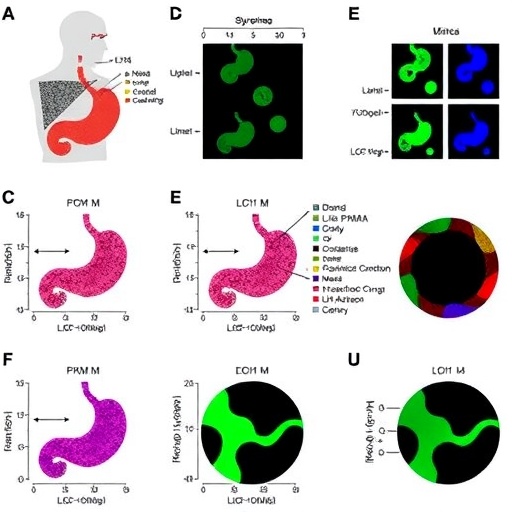In a groundbreaking study, researchers have unveiled profound insights into the interplay between metabolic pathways and cancer progression, particularly focusing on gastric cancer. With millions affected worldwide, the urgency to decode the mechanisms underlying this disease is more crucial than ever. The research, led by Yang, J., Yu, Z., and Feng, Y., presents a compelling narrative about the CLIC1-PKM2 axis and its pivotal role in augmenting glycolytic metabolism, a key energy-producing process within our cells. This emerging biochemistry offers not only a deeper understanding of gastric cancer but potential new therapeutic targets that could revolutionize treatment options.
Cancer cells exhibit distinct metabolic phenotypes compared to normal cells, which has spurred interest in their specific biochemical pathways. The CLIC1-PKM2 axis is positioned at the nexus of crucial metabolic processes, where chloride intracellular channel 1 (CLIC1) interacts with pyruvate kinase isozyme M2 (PKM2). This study meticulously elucidates how this interaction enhances the glycolytic process, allowing cancer cells to thrive under conditions of limited oxygen, a phenomenon known as the Warburg effect. By harnessing these findings, future therapies could aim to disrupt this axis, potentially starving tumor cells of the energy they require to grow and spread.
The findings from this research are particularly significant in the context of gastric cancer, a malignancy notoriously associated with poor prognosis and limited treatment options. The team’s investigations revealed that elevated levels of CLIC1 correspond with aggressive tumor behavior and poor patient outcomes. As such, it raises the tantalizing prospect that CLIC1 could serve as a robust biomarker for gastric cancer, aiding in both diagnosis and the monitoring of disease progression. More importantly, targeting this marker could lead to innovative treatment strategies that enhance therapeutic efficacy.
It’s noteworthy that the classical view of tumor metabolism is being challenged by this new paradigm, with an emphasis on how specific metabolic pathways facilitate tumor growth and survival. The interaction between CLIC1 and PKM2 exemplifies how cancer cells can adapt their metabolism to exploit alternative energy pathways. The study’s authors provide a thorough analysis of this interaction, examining enzymatic activities and downstream metabolic consequences. Understanding these mechanisms at an in-depth biochemical level paves the way for the development of novel inhibitors that could thwart cancer cell proliferation.
Moreover, the study compels us to reconsider existing therapeutic approaches. Current treatments for gastric cancer, such as chemotherapy and targeted therapy, have shown limited successes. By integrating metabolic reprogramming into our therapeutic arsenal, clinicians could personalize treatment options that more effectively combat the unique metabolic needs of gastric tumors. Furthermore, with a focus on the CLIC1-PKM2 axis, researchers may uncover additional vulnerabilities within the metabolic networks of gastric cancer cells that were previously overlooked.
The potential integration of metabolic inhibitors into treatment regimens could herald a new era of precision medicine for gastric cancer patients. By targeting the molecular machinations that drive tumor growth, oncologists may not only enhance the efficacy of existing therapies but may also extend survival rates and improve quality of life. This focus on the metabolic dependencies of cancer cells underscores a paradigm shift in how we approach treatment and opens avenues for innovative research that could lead to breakthrough therapies.
The research also highlights the importance of collaborative efforts across disciplines. The complexities of cancer demand integrative approaches that combine biochemistry, oncology, and molecular biology. Multi-institutional collaborations could facilitate the rapid translation of laboratory findings into clinical applications. The convergence of these fields is vital to unraveling the intricate metabolic networks that sustain cancer, thus accelerating the development of actionable therapies that can combat this disease effectively.
In summary, the investigators provide a compelling case for the involvement of the CLIC1-PKM2 axis in the metabolic rewiring of gastric cancer cells. Their results suggest that by targeting this axis, it may be possible to hinder cancer progression and offer patients new hope for effective treatment. The implications of this research extend beyond the realm of gastroenterology, potentially informing treatment strategies for other malignancies where similar metabolic alterations are observed.
As research efforts continue to unravel the complexities of cancer metabolism, it will be essential to remain vigilant for new therapeutic targets. This study serves as a stepping stone towards understanding metabolic dysregulation in cancer cells, reinforcing the notion that manipulating metabolic pathways could yield significant benefits in cancer therapy. The potential interaction of the CLIC1-PKM2 axis with other metabolic and signaling pathways provides a rich ground for future exploration that could further elucidate the multifaceted nature of gastric cancer.
The immediate future appears promising for those affected by gastric cancer, thanks to the relentless pursuit of researchers dedicated to discovering transformative pathways in cancer metabolism. As we continue to grapple with the challenges posed by this aggressive disease, insights from studies like this one may illuminate new paths forward, enhancing therapeutic strategies and patient outcomes in ways we are only beginning to comprehend. The collaboration between basic and clinical researchers will undoubtedly be imperative in translating these laboratory findings into groundbreaking clinical applications.
In conclusion, the research conducted by Yang, J., Yu, Z., and Feng, Y. lays crucial groundwork for our understanding of the metabolic mechanisms underpinning gastric cancer. The CLIC1-PKM2 axis emerges as a critical player in the orchestration of glycolytic metabolism, substantiating its potential as a target for innovative therapeutic development. This pioneering work opens a new chapter in the ongoing battle against gastric cancer, inspiring hope in patients and clinicians alike.
Subject of Research: Exploration of the CLIC1-PKM2 axis and its role in glycolytic metabolism in gastric cancer progression.
Article Title: The CLIC1-PKM2 axis orchestrates glycolytic metabolism to accelerate gastric cancer progression.
Article References:
Yang, J., Yu, Z., Feng, Y. et al. The CLIC1-PKM2 axis orchestrates glycolytic metabolism to accelerate gastric cancer progression.
J Transl Med (2025). https://doi.org/10.1186/s12967-025-07463-6
Image Credits: AI Generated
DOI: 10.1186/s12967-025-07463-6
Keywords: gastric cancer, CLIC1-PKM2 axis, glycolytic metabolism, cancer progression, metabolic pathways.
Tags: biochemical pathways in oncologycancer cell metabolismchloride intracellular channel 1 functionCLIC1-PKM2 axis in gastric cancerenergy metabolism in cancergastric cancer researchglycolysis in cancer metabolismmetabolic pathways in gastric cancernovel cancer therapiespyruvate kinase isozyme M2 roletherapeutic targets in cancer treatmentWarburg effect in tumor cells





